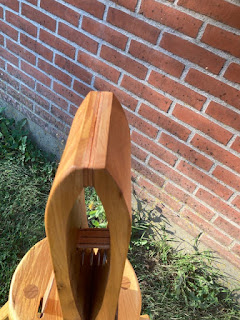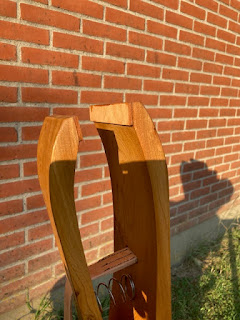We had made a draft of who should give who Christmas presents on board. And my recipient had earlier on wished for a belt, so I made a nice wide belt that would fit in a set of jeans for her. I decided that I could make a keepsake box for her as well. That way it would also be easier to make a decent gift wrapping. :-)
I found a piece of birch that I had milled a couple of years ago, and I decided that it would be a fine material. I have never really worked birch before, other than for firewood, so I thought that it would be interesting to do a nice little project with it.
I settled on some measurements that looked fine to me and would enable me to make the panels for the lid and bottom without gluing anything up.
the board was first crosscut into some manageable lengths and then planed to the desired thickness.
The sides were ripped to the correct width and I made a groove on for the lid and the bottom, so that I could assemble the box completely and later on divide it on the table saw.
I laid out some dovetails and took into account that 1/8" would be removed from one of the sets when I reopened the box. I just made regular through dovetails, and after dry assembling the sides I measured for the lid and bottom and made those too. those received a rabbet going all the way around, so they could seat in the grooves of the sides once assembled.
After the glue had dried, I planed the protruding parts of the dovetails flush with the rest, and sanded the box lightly. I adjusted the table saw to nearly the depth of the material, so that when I separated the box I would not risk any movement or binding. I could just as well have glued in some small blocks of wood on the inside prior to assembly, but I chose the other route this time. The final separation was done with a Japanese pull saw.
I made some dust seal strips that would be mounted inside the bottom of the box. These all received an angled cut near the upper part. The depth of the cut was close to 1/32", just the same as the thickness of the fabric that I would use to line the box with.
The dust seals were glued in place, and I installed some small brass hinges that I once got from my brother in japan. I decided that I didn't want to ad a lock to the box, so from that point on it was just downhill smooth sailing. (The Danish expression downhill apparently means something different in English :-) )
I gave the box three coats of shellac with a rubbing of steel wool in between each layer. After the final layer I lightly rubbed with steel wool again, and then gave the surface a coat of wax.
Some years ago I ordered a length of baize from Hainsworth in England. This is the fabric that was originally used in gun cases and such. Due to various reasons I never have gotten around to test it before now, and I have to say that it is an incredibly nice material!
It looks way better than any of my earlier attempts using hobby felt which is actually a synthetic instead of real wool. The baize has a beautiful dark holly colour and it is much more firm so it is easier to cut and position inside the box.
Based on information that I once read on the "pegs and tails blog", baize was traditionally glued using glue made from wheat flour.
So armed with this information I found a recipe for wheat flour and started. the recipe called for 1 part of flour to 4 parts of cold water. The flour is mixed thoroughly with the cold water and the mixture is then brought to boil and left to boil while stirred until it thickens.
The glue worked a lot better than I had anticipated, and in a short time the keepsake box was complete.
Assembled box
Almost separated
Just separated
The new puppy resting its tired little head on the soft cushion of our lovely Newfoundland dog
Getting ready to glue using wheat flour glue
Baize glue up in progress.
The keepsake box has been lined
Completed box ready for Christmas wrapping






















































